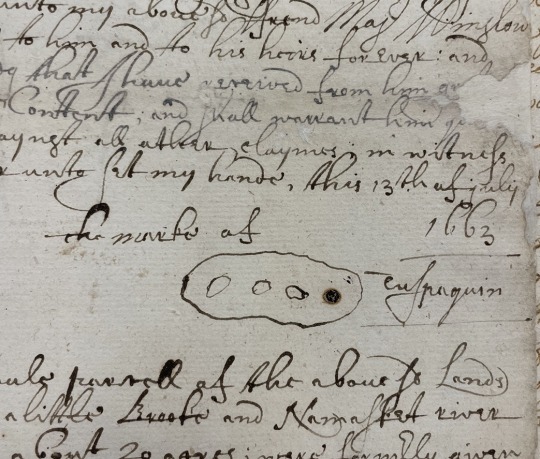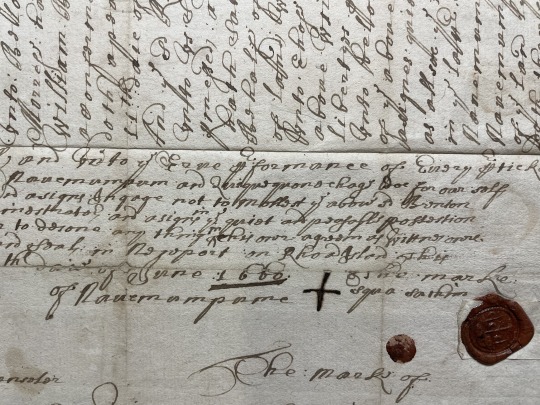#pometacom
Text


Osamekins Chefe Satchim. Ousamequin, Massasoit. Their Mark.
Pokanoket. His home at Sowams, on present-day Wampanoag homelands and in the southeastern parts of so-called “Rhode Island and Massachusetts.” As Great Sachem or Massasoit of the Wampanoag, Ousamequin led the people of the first light through the time of the great plague (1616-1619) and signed a treaty with European settler-colonizers in 1621, just after those settlers first arrived to the shores of Wampanoag territory. Ousamequiin continued to navigate a tenuous relationship with colonizers until his death in 1661. In this deed, signed in 1651, Ousamequin and other “nabor satchims” acknowledge the sovereignty and leadership power of their “beloved cosin” Nummampaum (Weetamoo) in her own territory at Pocasset.
Ousamequin’s kin: sons: Wamsutta, Pometacom and Sonkanuhoo. Daughters: Amie and another whose name I am so far uncertain of.
Deed signed July 26, 1651. Seen at the Massachusetts Historical Society.
Ousamequin means yellow feather in the Wampanoag dialect of the Algonquian language.
#ousamequin#pokanoket#wampanoag#sowams#massasoit#wamsutta#pometacom#theirmarks#rhodeisland#massachusetts#easternwoodlands#nativehistory#sachem#17thcentury#weetamoo#masshistorical#algonquian
2 notes
·
View notes
Text

The Marke of Tuspaquin.
Wampanoag, at Nemasket and Assawompset (in the areas today called “Middleboro” and “Lakeville, Massachusetts”). In this signed document, discussing land at Nemasket, Tuspaquin identifies as “Tuspaquin (alias) the Black Sachem of Namassakat.”Fought alongside Pometacom in the First Indian War (or Metacom’s War, or King Philip’s War), and was executed by colonizers in September, 1676.
Tuspaquin’s kin: son of Pamontaquask. A partner, Amie (daughter of Ousamequin and sister of Pometacom and Wamsutta), their sons, Benjamin and WIliam Tuspaquin.
Deed signed July 13, 1663. Seen at the American Antiquarian Society.
#tuspaquin#sachem#wampanoag#nemasket#assawompset#massachusetts#theirmarks#17thcentury#17c#americanantiquariansociety#algonquian#easternwoodlands#nativehistory#pometacom#ousamequin
1 note
·
View note
Text

Weetamoo. Tatapanunum. Namumpum. Nauemampome. Their mark.
Her home at Pocasset - present day “Tiverton, Rhode Island,” Quequechan or “Fall River, Massachusetts” and surrounding areas. Sachem of Pocasset. Kinship ties throughout Pokanoket, Wampanoag, Massachusett, Narragansett territories. During the First Indian War (also called King Philip’s War), led raids against colonizers throughout Nipmuc, Massachusett and Wampanoag homelands. In 1676, her body found in the Taunton River, then dismembered by colonizers and displayed for public view at so-called “Taunton, Massachusetts” for two decades. Two decades.
Kin: her father, Corbitant, her sister Wootonakanuske, a partner, Winnepurket, a partner Wamsutta (brother of Pometacom and son of Ousamequin), a partner, Quequequanchet, a partner, Petonowowetta, a partner Quinnapin (son of Ninigret).
This deed signed June 1660. Seen at Massachusetts Historical Society.
#pocasset#wampanoag#fallriver#taunton#weetamoo#namumpum#theirmarks#easternwoodlands#nativehistory#17thcentury#17c#massachusetts#rhodeisland#masshistorical#algonquian#wamsutta#ousamequin#wootonakanuske#sachem#pometacom#kingphilipswar#firstindianwar
1 note
·
View note
Text

Pometacom. Metacomet. Metacom. King Phillip. His mark.
Wampanoag. His home at Pokanoket. Born 1638. A Wampanoag sachem by 1662, after his brother's suspicious death. A diplomat and strategist. Led a confederation of Eastern Woodlands tribes in a rebellion against colonizers in the First Indian War (or King Philip's War), 1675-1676. Fought to reclaim sovereignty, resist subjugation and dispossession, and for #landback.
Assassinated August 12, 1676; dismembered upon his death. Colonizers displayed his head on a spike at so-called Plymouth for over two decades.
His kin: father Ousamequin, the Massasoit. A brother, Wamsutta. Wamsutta’s partner, Namumpum (later called Weetamoo). Pometacom’s partner, Wootonekanuske.
"Quitclaim by Phillip." Rehoboth, Mass. 1668. Seen @ John Carter Brown Library, Providence, RI.
#wampanoag#pokanoket#pometacom#metacom#metacomer#kingphillip#hismark#theirmarks#easternwoodlands#nativehistory#sachem#17thcentury#firstindianwar#johncarterbrownlibrary#massachusetts#rhodeisland#wamsutta#ousamequin#massasoit#algonquian#weetamoo#namumpum#wootonekanuske
0 notes
Text

Alexander or Wamsutta or else Sepaquitt. Their Mark.
Pokanoket, Wampanoag. His homelands across the southeastern coasts of the places commonly called Massachusetts and Rhode Island. Leader of the Wampanoag confederacy upon the death of his father, Ousamequin in 1661. Suspected by colonizers of Mass. Bay colony of colluding with the Narragansett against them; Wamsutta also angered European settlers in Massachusetts because of his land transactions with settlers in so-called Rhode Island. Wamsutta died suspiciously in 1662 after being detained and questioned by English settlers.
Their kin: A partner, Namumpum or Weetamoo. Their father Ousamequin, the Massasoit. Brothers Pometacom (or Philip) and Sonkanuhoo; sisters Amie and another whose name I am so far uncertain of.
This deed signed by Wamsutta on January 20, 1661, for lands bounded by the so-called “Seven Mile River ….southward till it come to the main sea, and then to run by the sea westward to Seconet.” John Sassamon is listed as “Interpreter Indian” at the signing of the deed.
#Seen at the Massachusetts State Archives.#wampanoag#pokanoket#wamsutta#alexander#sepaquitt#theirmark#theirmarks#easternwoodlands#nativehistory#sachem#17thcentury#firstindianwar#massstatearchives#massachusetts#rhodeisland#weetamoo#ousamequin#algonquian#namumpum#pometacom#johnsassamon
3 notes
·
View notes
Text

Pumham. Sachem of Showhomett Pumhomm.
Sachem at Shawomet, or so-called “Warwick, Rhode Island,” Pumham had an interesting and well documented relationship with both English colonizers and Narragansett relatives. Settlers in Warwick tried to arrest Pumham for an insurrection attempt in 1659 and later moved to expel Pumham from Shawomet altogether, in 1667. Pumham refused to leave and would remain in Shawomet until he was killed by settlers in July of 1676 while fighting with Pometacom in King Philip’s War.
In this document, Pomham signs as witness to a transfer of land “lyinge uppon the west syde of that part of the sea called Sowhanes Bay, from Copassanatuxett, over against a little island in the sayd bay, being the north bounds, and the outmost point that neck of land called Shawhomet…” signed by Miantonomo.
Their kin: at least two sons, one named Cheesechamut.
[Indian deed of Warwick, Rhode Island], 1642. Seen @ John Carter Brown Library.
#nahaganset#narragansett#pumham#miantonomo#theirmarks#easternwoodlands#nativehistory#sachem#17thcentury#rhodeisland#johncarterbrownlibrary#warwick#shawhomet#algonquian
0 notes